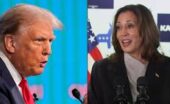Re The UN General Assembly Speaker Schedule is Here! I note that whoever will be speaking for Canada this year…
2024 U.S. campaign & election November-
Written by Diana Thebaud Nicholson // November 4, 2024 // Government & Governance, Politics // No comments
2024 U.S. election campaign 20 June-31 October
 Red states and blue states
Red states and blue states
Starting with the 2000 United States presidential election, the terms “red state” and “blue state” have referred to US states whose voters vote predominantly for one party—the Republican Party in red states and the Democratic Party in blue states—in presidential and other statewide elections. By contrast, states where the vote fluctuates between the Democratic and Republican candidates are known as “swing states” or “purple states”. Examining patterns within states reveals that the reversal of the two parties’ geographic bases has happened at the state level, but it is more complicated locally, with urban-rural divides associated with many of the largest changes.
4 November
How Is It This Close?
The most remarkable thing about the 2024 presidential election is that roughly half the electorate still supports Donald Trump.
By David A. Graham
(The Atlantic) Some of the important reasons the election is so close are structural and have little to do with Trump or Harris. Underlying characteristics of the election benefit the Republican nominee: Voters in the United States are unhappy about the direction of the country, and voters around the world have been punishing incumbents. Although Harris is not the president, she has struggled to figure out how much to distance herself from Joe Biden and the administration in which she serves as vice president. Americans are also sour on the economy, and although the U.S. has weathered the post-COVID world and global inflation better than any of its peers, saying that is no use if voters don’t feel and believe it.
The Real Election Risk Comes Later
Amid heightened tensions, officials across the country are taking measures to keep voting secure and safe. It could be a long job.
By Elaine Godfrey
(The Atlantic) One week ago, in the middle of early voting, an arsonist attached incendiary devices to two ballot-drop boxes, one in Oregon and another in Washington State. Hundreds of ballots were scorched or burned beyond recognition.
Election experts and local leaders anticipate that this week, and probably some weeks after, will bring a torrent of election disinformation, online threats, and in-person tensions that could boil over into violence.
In response, officials across the country have transformed their tabulation centers into fortresses, with rolls of razor wire atop their fences and ballistic film reinforcing their windows. Election staffers are running drills with law-enforcement officers, studying nonviolent de-escalation tactics, and learning protocols for encountering packages containing mysterious white powder.
The more pressing concern, however, is what happens after Tuesday, in that period, fraught with impatience, between when election workers are counting votes and the results are confirmed. During this interval—which may be only hours, but may run to days in some places—there will be little actual news and many attempts to create some: At the very moment when a watchful press will be desperate for new developments, conspiracy theorists and Donald Trump’s allies will be intent on sowing chaos and doubt. …
In Pennsylvania, a race to keep voters from having their ballots thrown away
Thousands of voters are at risk of having their ballots cancelled due to simple errors, such as forgetting to date or sign the outer envelope.
3 November
Harris and Trump Battle to the Wire in Swing States, Times/Siena Polls Find
Donald J. Trump has improved his standing in Pennsylvania even as late-deciding voters appear to be breaking for Kamala Harris.
The presidential race appears to be hurtling toward a photo finish, with the final set of polls by The New York Times and Siena College finding Vice President Kamala Harris showing new strength in North Carolina and Georgia as former President Donald J. Trump erases her lead in Pennsylvania and maintains his advantage in Arizona.
It has been decades since the polls have shown the nation facing a presidential race that is so close across so many states in both the Sun Belt and the Rust Belt. The tightly contested landscape means the race remains highly uncertain as the campaign enters its final hours.
Ms. Harris is now narrowly ahead in Nevada, North Carolina and Wisconsin, the polls show, while Mr. Trump leads in Arizona. The polls show them locked in close races in Michigan, Georgia and Pennsylvania. But the results in all seven states are within the margin of sampling error, meaning neither candidate has a definitive lead in any of them.
2 November
Harris said to plan ‘SNL’ appearance as she and Trump both court North Carolina
Both Vice President Kamala Harris and former president Donald Trump are aiming to get out the vote in North Carolina, where polls show the candidates within the margin of error. Heading into Election Day, Harris is continuing her star-studded rallies, stopping first in Atlanta for an appearance that included Spike Lee and performances by 2 Chainz and others. Later, she held a rally in Charlotte, with remarks by Kerry Washington and performances by singers including Brittney Spencer and Jon Bon Jovi. Her running mate, Minnesota Gov. Tim Walz, was in Las Vegas to mobilize the vote and is now in Arizona for stops in Flagstaff and Tucson. Trump held a rally in Gastonia, North Carolina, and was next scheduled to appear in Salem, Virginia, outside Roanoke, and Greensboro, North Carolina.
1 November
The 7 most likely scenarios for Election Day
Aaron Blake
The Washington Post’s polling averages show that all seven swing states are separated by two points or less. That means if things move only two points from where we think they stand, you could see a swing-state sweep for either candidate and a pretty decisive election — at least, in the electoral college.
Given all that uncertainty, I thought it worth walking through the most likely scenarios, as things appear to stand now, and how we might arrive at a victory for either candidate.
Here are seven of them, in rough order of plausibility — but with just about all of them being plausible.
1. A Harris squeaker — most likely via the ‘blue wall’
This would seem the most likely scenario, according to The Washington Post’s polling averages. That doesn’t mean it’s likely, period — just more likely than the others. …
The reason is that Harris currently holds a slight lead in four of seven swing states — Michigan, Nevada, Wisconsin and Pennsylvania — which puts her on course for 276 electoral votes (with 270 required)
And all she really needs are three: the Northern “blue wall” states. Throw in Nebraska’s 2nd Congressional District — where she leads by around 10 points — and Harris gets to exactly 270.
Five of the Election’s Biggest Unanswered Questions
When the votes are counted, we will learn more than just who won.
By Rogé Karma
(The Atlantic) Every presidential election appears to pose one big question—who will win?—that is in fact made up of countless smaller questions: How do voters really behave? Which old rules of politics still apply, and which are obsolete? What kind of country do we live in? In 2016, we learned that white evangelical voters would overwhelmingly support a louche serial philanderer. Four years later, we learned that Florida had shifted from the quintessential swing state to a Republican stronghold. Here are five of the biggest outstanding questions heading into next week’s vote.
Will the polls finally be right?
Will we finally see a youth gender gap?
Are Democrats losing Black and Hispanic support?
Does the economy matter?
Do campaigns make a difference?
The seven swing states set to decide the 2024 US election
(BBC) About 240 million people are eligible to vote in the 2024 US election, but only a relatively small number of them are likely to decide who becomes the next president.
Experts believe there are only a handful of so-called “swing” states that could plausibly be won by either Democrat Kamala Harris or Republican Donald Trump.
Seven of these – Arizona, Georgia, Michigan, Nevada, North Carolina, Pennsylvania and Wisconsin – are thought to hold the keys to the White House.
Both campaigns have therefore been targeting undecided voters in these states.
(NYT) Washington Gov. Jay Inslee says he is activating the state’s National Guard, placing personnel on standby in case they need to respond to “civil unrest” related to the election. The decision comes after ballot boxes were set on fire in the region and amid what Inslee described as “the potential for further violence and illegal activity.”
Why you should be paying close attention to statehouse elections
The last two years of divided control in Washington have spotlighted the degree to which state lawmakers are driving the country’s policy agenda. On issues like privacy protections, school vouchers and abortion access, gridlock on Capitol Hill has empowered state legislatures to fill the void.
While the outcome in Nov. 5 remains up in the air, there’s one thing that is clear: Much of the country’s most important legislative action will remain in the states.



